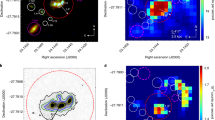Abstract
Ultraluminous infrared galaxies have been known for more than a decade, but the source of their very large far-infrared luminosities remains controversial. It may reflect a quasar-like active nucleus surrounded by a torus of dense gas and dust, the latter absorbing the energetic photons from the nuclear region and re-emitting at infrared wavelengths1, or a huge burst of massive-star formation in dense dusty clouds of molecular gas close to the nucleus2, which heats the surrounding dust. A number of ultraluminous galaxies are also a source of OH-megamaser emissions (intense laser-like spectral lines at microwave frequencies), an observation that may hold important clues as to the main power source in these galaxies. A general feature of many models3,4 is that the masers are pumped radiatively by the absorption of infrared photons. Identifying the source of the maser pump may therefore indicate whether the ultimate energy source is a burst of star formation, or an active nucleus. Here we report the detection of a strong mid-infrared OH absorption line in the prototypical megamaser and ultraluminous galaxy5, Arp220. We find that the power absorbed in this line alone is sufficient to pump the megamaser emission seen at radio wavelengths. Moreover, the warm, extended nature of the pumping region is suggestive of a starburst origin for the ultraluminous infrared emissions.
This is a preview of subscription content, access via your institution
Access options
Subscribe to this journal
Receive 51 print issues and online access
$199.00 per year
only $3.90 per issue
Buy this article
- Purchase on Springer Link
- Instant access to full article PDF
Prices may be subject to local taxes which are calculated during checkout
Similar content being viewed by others
References
Sanders, D. B. et al. Ultraluminous infrared galaxies and the origin of quasars. Astrophys. J. 325, 74–91 (1988).
Solomon, P. M. & Sage, L. J. Star-formation rates, molecular clouds, and the origin of the far-infrared luminosity of isolated and interacting galaxies. Astrophys. J. 334, 613–625 (1988).
Henkel, C., Güsten, R. & Baan, W. A. Rotationally excited OH in megamaser galaxies. Astron. Astrophys. 185, 14–24 (1987).
Randell, J., Field, D., Jones, K. N., Yates, J. A. & Gray, M. D. The OH zone in OH megamaser galaxies. Astron. Astrophys. 300, 659–674 (1995).
Baan, W. A., Wood, P. A. D. & Hashchick, A. D. Broad hydroxyl emission in IC 4553. Astrophys. J. 260, L49–L52 (1982).
Baan, W. A. in Astrophysical Masers (eds Clegg, A. W. & Nedoluha, G. E.) 73–82 (Springer, Berlin, 1993).
Baan, W. A. Infrared properties of OH galaxies. Astrophys. J. 338, 804–811 (1989).
Graham, J. R. et al. The double nucleus of Arp 330 unveiled. Astrophys. J. 354, L5–L8 (1990).
Baan, W. A. & Haschick, A. D. Nuclear antics of 1C 4553 (Arp 220). Astrophys. J. 454, 745–748 (1995).
Diamond, P. J., Norris, R. P., Baan, W. A. & Booth, R. S. VLBI observations of the OH megamaser in IC 4553 (Arp 220). Astrophys. J. 340, L49–L52 (1989).
Lonsdale, C. J., Diamond, P. J., Smith, H. E. & Lonsdale, C. J. Compact OH megamaser and probable quasar activity in the galaxy Arp 220. Nature 370, 117–120 (1994).
Goldreich, P., Scoville, N. OH/IR Stars I—Physical properties of circumstellar envelopes. Astrophys. J. 205, 144–154 (1976).
Savage, B. D. & Mathis, J. S. Observed properties of interstellar dust. Annu. Rev. Astron. Astrophys. 17, 73–111 (1979).
Sturm, E. et al. ISO-SWS spectroscopy of Arp 220: a highly obscured starburst galaxy. Astron. Astrophys. 315, L133–L136 (1996).
Lutz, D. et al. What powers luminous infrared galaxies? Astron. Astrophys. 315, L137–L140 (1996).
Destombes, J. L., Marliere, C., Baudry, A. & Brillet, J. The exact hyperfine structure and Einstein A-coefficients of OH—consequences in simple astrophysical models. Astron. Astrophys. 60, 55–60 (1977).
Author information
Authors and Affiliations
Rights and permissions
About this article
Cite this article
Skinner, C., Smith, H., Sturm, E. et al. A starburst origin of the OH-megamaser emission from the galaxy Arp220. Nature 386, 472–474 (1997). https://doi.org/10.1038/386472a0
Received:
Accepted:
Issue Date:
DOI: https://doi.org/10.1038/386472a0
This article is cited by
-
Far infrared properties of OH megamaser host galaxies
Journal of Astrophysics and Astronomy (2023)
-
OH megamasers: dense gas & the infrared radiation field
Journal of Astrophysics and Astronomy (2018)
-
Obscured Activity: AGN, Quasars, Starbursts and ULIGs Observed by the Infrared Space Observatory
Space Science Reviews (2005)
Comments
By submitting a comment you agree to abide by our Terms and Community Guidelines. If you find something abusive or that does not comply with our terms or guidelines please flag it as inappropriate.



